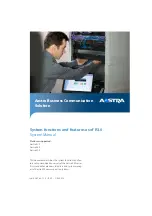
Appendix A. Server racks and energy management
57
IBM EnergyScale technology
IBM EnergyScale technology provides functions to help the user understand and dynamically
optimize processor performance versus processor energy consumption, and system
workload, to control Power Systems power and cooling usage.
EnergyScale uses power and thermal information that is collected from the system to
implement policies that can lead to better performance or better energy usage. EnergyScale
offers the following features:
Power trending
EnergyScale provides continuous collection of real-time server energy consumption.
Administrators can use it to predict power consumption across their infrastructure and to
react to business and processing needs. For example, administrators can use this
information to predict data center energy consumption at various times of the day, week,
or month.
Power saver mode
Power saver mode lowers the processor frequency and voltage a fixed amount, reducing
the energy consumption of the system while still delivering predictable performance. This
percentage is predetermined to be within a safe operating limit and is not
user-configurable. The server is designed for a fixed frequency drop of almost 50% down
from nominal frequency (the actual value depends on the server type and configuration).
Power saver mode is not supported during system start, although it is a persistent
condition that is sustained after the start when the system starts running instructions.
Dynamic power saver mode
Dynamic power saver mode varies processor frequency and voltage based on the usage
of the POWER8 processors. Processor frequency and usage are inversely proportional for
most workloads, implying that as the frequency of a processor increases, its usage
decreases, given a constant workload. Dynamic power saver mode takes advantage of
this relationship to detect opportunities to save power, based on measured real-time
system usage.
When a system is idle, the system firmware lowers the frequency and voltage to power
energy saver mode values. When fully used, the maximum frequency varies, depending
on whether the user favors power savings or system performance. If an administrator
prefers energy savings and a system is fully used, the system reduced the maximum
frequency to about 95% of nominal values. If performance is favored over energy
consumption, the maximum frequency can be increased to up to 111.3% of nominal
frequency for extra performance.
Dynamic power saver mode is mutually exclusive with power saver mode. Only one of
these modes can be enabled at a time.
Power capping
Power capping enforces a user-specified limit on power usage. Power capping is not a
power-saving mechanism. It enforces power caps by throttling the processors in the
system, degrading performance significantly. The idea of a power cap is to set a limit that
must never be reached but that frees extra power that was never used in the data center.
The
margined
power is this amount of extra power that is allocated to a server during its
installation in a data center. It is based on the server environmental specifications that
usually are never reached because server specifications are always based on maximum
configurations and worst-case scenarios.
Summary of Contents for S822LC
Page 2: ......
Page 10: ...THIS PAGE INTENTIONALLY LEFT BLANK...
Page 14: ...xii IBM Power Systems S822LC for High Performance Computing...
Page 74: ...60 IBM Power Systems S822LC for High Performance Computing...
Page 78: ...64 IBM Power Systems S822LC for High Performance Computing...
Page 79: ......
Page 80: ...ibm com redbooks Printed in U S A Back cover ISBN REDP 5405 00...










































